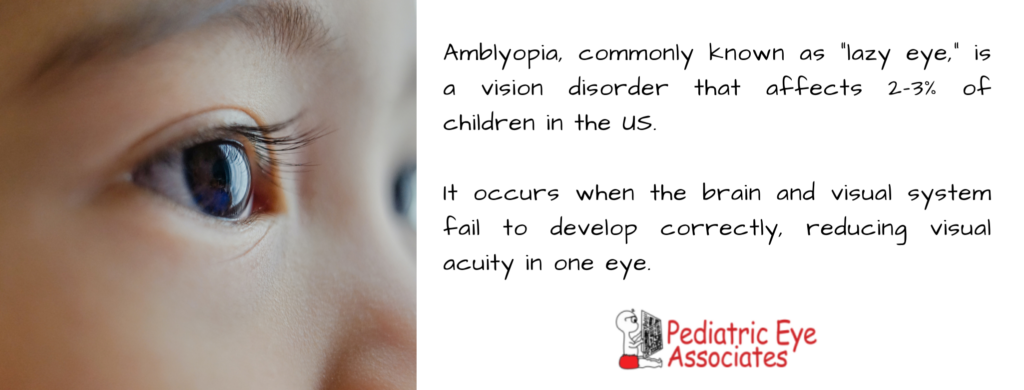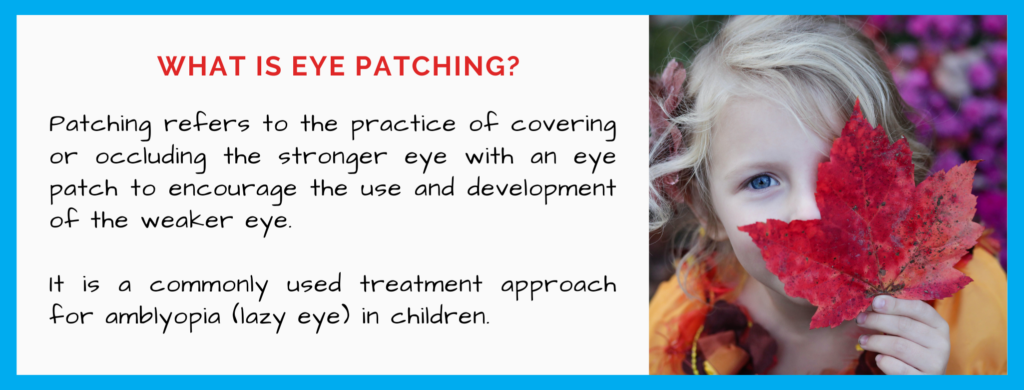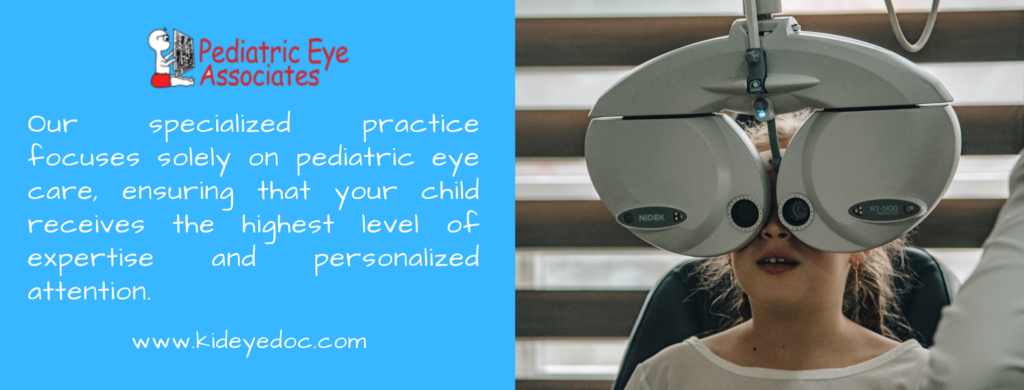Amblyopia, commonly known as “lazy eye,” is a vision disorder that affects 2-3% of children in the United States. It occurs when the brain and visual system fail to develop correctly, reducing visual acuity in one eye. However, there is hope.
Through the use of eye patching, we can stimulate visual development and empower children to unlock their vision potential. In this blog, we will explore patching of the eye as a tried-and-true treatment option, exploring its mechanisms, benefits, and practical implementation.
What is amblyopia?
Amblyopia is a vision disorder that occurs when the brain and the visual system fail to develop properly in early childhood. It is characterized by reduced visual acuity in one eye, even with the use of glasses or contact lenses.
Amblyopia can occur due to several factors, including strabismus (misaligned eyes), refractive errors (unequal focus between the eyes), or deprivation (obstruction of vision in one eye).
When one eye has significantly better focus or alignment than the other, the brain tends to rely more on the stronger eye, causing the weaker eye to receive less visual stimulation. As a result, the visual pathways in the brain fail to develop fully, leading to reduced visual acuity in the affected eye.
The signs and symptoms of amblyopia in children can include:
- Reduced vision in one eye compared to the other.
- Poor depth perception.
- Squinting or closing one eye.
- Struggling with fine visual tasks, such as reading or recognizing small objects.
- Difficulty judging distances accurately.
- Lack of interest in activities that require visual focus.
- Frequently bumping into objects or tripping.
- An abnormal alignment of the eyes (strabismus).
- Differences in the appearance of the eyes (such as one eye appearing to turn inward or outward).
How is amblyopia diagnosed in children?
Amblyopia is typically diagnosed through a comprehensive eye examination performed by an optometrist or ophthalmologist. The diagnostic process for amblyopia in children may involve the following:
-
Visual acuity testing
This test uses an eye chart to measure the clarity of vision in each eye individually. It helps identify any significant differences in visual acuity between the eyes.
-
Refraction test
The eye doctor may conduct a refraction test to determine if the child has any refractive errors, such as nearsightedness, farsightedness, or astigmatism, which can contribute to amblyopia.
-
Ocular alignment and binocular vision assessment
The doctor will examine the alignment of the eyes to check for strabismus or any other misalignment. Additionally, tests may be conducted to assess the child’s ability to coordinate both eyes together (binocular vision).
-
Pupil examination
The doctor may examine the pupils to ensure they react appropriately to light and to rule out any underlying eye conditions.
-
Retinal examination
Dilating eye drops may be used to examine the retina and the back of the eye, which helps detect any structural abnormalities or signs of underlying eye conditions.
-
Additional tests
In some cases, additional tests, such as visual field testing or imaging scans, may be recommended to evaluate the extent of visual impairment or to assess the health of the eyes and the visual pathways.
Based on the findings from these tests, the eye doctor can diagnose amblyopia and determine the appropriate treatment plan for the child. Children must undergo regular eye examinations, even if they do not show any signs or symptoms of amblyopia, as early detection is crucial for successful treatment outcomes.
What is patching?
Patching refers to the practice of covering or occluding the stronger eye with an eye patch to encourage the use and development of the weaker eye. It is a commonly used treatment approach for amblyopia (lazy eye) in children. The patch is typically placed over the unaffected or stronger eye, forcing the child to rely more on the amblyopic eye for visual tasks.
The duration and frequency of patching can vary based on the severity of amblyopia and the individual child’s needs. Eye care professionals typically provide specific guidelines on how long the patch should be worn each day and for how many days or weeks the patching treatment should continue.
How does eye patching work in treating amblyopia?
The basic principle behind eye patching is to restrict the use of the stronger eye, which encourages the brain to rely more on the amblyopic eye for visual input. This active engagement of the weaker eye helps stimulate the visual pathways and improves visual acuity and binocular vision.
During the therapy, a patch is placed over the stronger eye, effectively covering it and limiting its visual input. Over time, this increased use of the weaker eye encourages the visual system to develop and strengthen, improving visual acuity in the affected eye.
How often should eye patching be done?
The duration and frequency of eye patching can vary depending on the severity of amblyopia and the individual child’s needs. Generally, eye patching is typically done daily, and the duration of each patching session can range from a few hours to several hours per day.
It is crucial to follow the specific patching schedule and duration prescribed by your eye care professional. They will monitor your child’s progress and make any necessary adjustments to the treatment plan as needed.
It is important to note that eye patching is often just one component of a comprehensive treatment plan for amblyopia. Other interventions may also be incorporated, such as such as corrective glasses, contact lenses, or vision therapy exercises,
When should patching treatment begin?
Patching treatment for amblyopia should begin as early as possible, typically during early childhood. The critical period for visual development occurs during the first few years of life, and early intervention offers the best chances for successful outcomes.
It is recommended to start patching treatment when amblyopia is diagnosed or suspected by an eye care physician. Beginning treatment early helps take advantage of the brain’s plasticity during this crucial stage, allowing for better stimulation and development of the weaker eye.
Early patching intervention can significantly improve visual acuity, depth perception, and overall visual function, setting a solid foundation for optimal visual development in the child’s formative years.
How do you ensure that children comply with wearing the eye patch?
Ensuring compliance with wearing the eye patch can be challenging, but some strategies can help encourage children to adhere to the treatment:
-
Explanation and education
Explain to the child the purpose and benefits of wearing the eye patch in a simple and age-appropriate manner. Help them understand that it will help make their weaker eye stronger and improve their vision.
-
Positive reinforcement
Use positive reinforcement techniques to motivate and reward the child for wearing the patch. Offer praise, stickers, small rewards, or a particular activity after successful patching sessions to make it more enjoyable.
-
Engaging patch designs
Consider using eye patches with fun and appealing designs or patterns. Allowing the child to choose their own patch design can make it feel more personalized and exciting for them.
-
Peer support
Encourage the child to wear the eye patch among supportive friends or siblings. When their peers understand and are supportive of the patching treatment, it can boost the child’s confidence and willingness to comply.
-
Patching routine
Establish a consistent patching routine and make it a part of the child’s daily schedule. Set specific times for wearing the patch each day and stick to the plan as much as possible.
-
Distraction and activities
Engage the child in enjoyable activities during patching, such as reading books, playing games, or watching movies. This helps divert their attention and makes the experience more enjoyable.
-
Parental involvement
Actively participate in the patching process as a parent or caregiver. Offer encouragement, support, and engage in activities together with the child during patching sessions. Your involvement can significantly influence their compliance.
-
Open communication
Maintain open communication with the child, addressing any concerns or discomfort they may have about wearing the patch. Listen to their feelings and experiences, and provide reassurance and support.
Remember, consistency, patience, and a positive approach are key when encouraging compliance with wearing the eye patch. Every child is unique, so it may be necessary to try different strategies that will suit their needs and preferences.
Where to find the best pediatric eye doctor in NJ?
At Pediatric Eye Associates, we understand the unique visual needs of children and are dedicated to providing exceptional eye care tailored specifically for them. We believe that every child deserves the best start in life, and that includes a healthy and clear vision.
Our specialized practice focuses solely on pediatric eye care, ensuring that your child receives the highest level of expertise and personalized attention.
Our team consists of a highly skilled and experienced pediatric optometrist and an ophthalmologist who have both dedicated their careers to caring for children’s vision. They possess the expertise to diagnose and treat a wide range of eye conditions specific to young patients, such as:
- Eye infection
- Pink Eye
- Myopia (nearsightedness)
- Amblyopia (lazy eye)
- Convergence insufficiency
- Diabetic eye disease
- Cataracts
- Pediatric stye
- Subconjunctival hemorrhage
- And more
Your child’s vision is our top priority. Contact us now to learn more.
The material contained on this site is for informational purposes only and DOES NOT CONSTITUTE THE PROVIDING OF MEDICAL ADVICE, and is not intended to be a substitute for independent professional medical judgment, advice, diagnosis, or treatment. Always seek the advice of your physician or other qualified healthcare providers with any questions or concerns you may have regarding your health.



